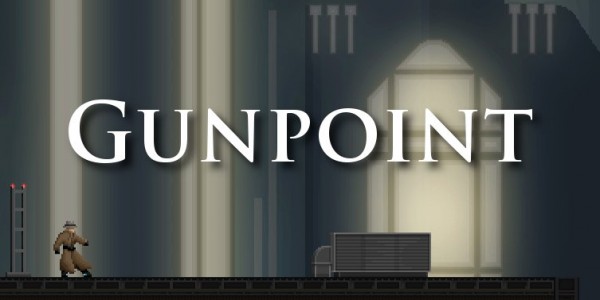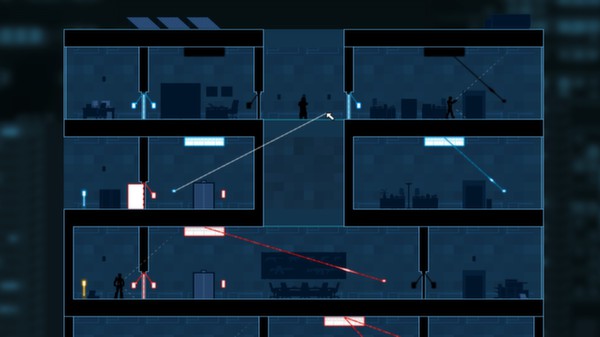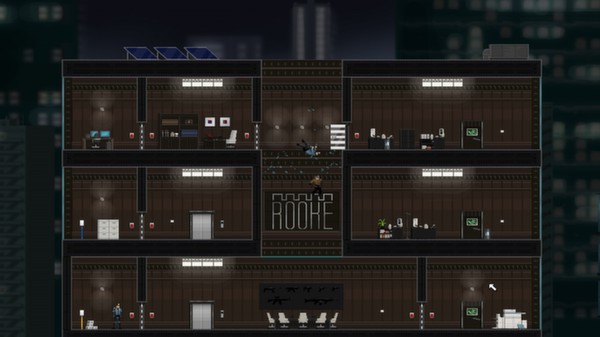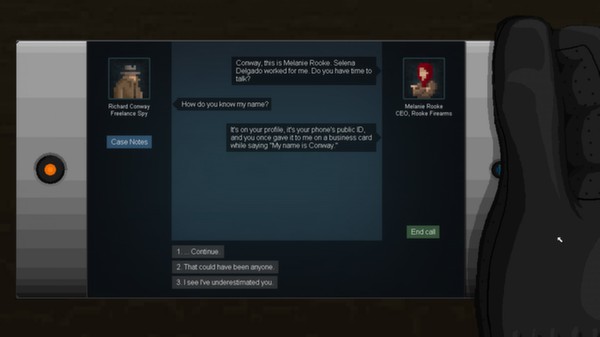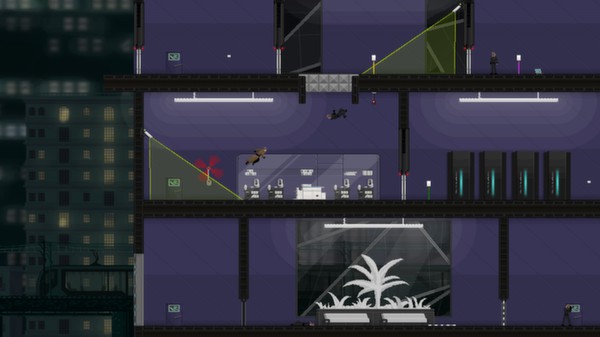Gunpoint‘s opening might seem familiar to anyone with experience in noir detective stories: freelance spy Richard Conway is contacted by a mysterious woman with a problem that needs to be solved. The twist that sets the stage for Gunpoint‘s blend of noir with snarky humor is that Conway is contacted after he inadvertently threw himself out of his apartment window while testing his new Bullfrog Hypertrousers. In any case, in typical noir fashion, the woman ends up murdered and Conway is the prime suspect. What starts as a mission to clear his name and find the real killer gradually unravels a plot about corporate espionage, blackmail, corruption, and betrayal.
Each level in this stealth-puzzle game requires you to navigate your way to a room containing either a computer terminal that needs to be hacked or some device that needs to be stolen. Your two primary gadgets for accomplishing this task are the Hypertrousers, which allow you to jump great distances and climb walls, and the Crosslink.
The Crosslink is the core gameplay mechanic of Gunpoint and your main means of solving each level’s puzzles. This device allows you to rewire various electronics throughout the level, affecting how they work and interact with other devices in the environment. This is done by simply opening your Crosslink and using your mouse to delete current connections and draw new ones. The most basic example of this might be rewiring a locked door so that a nearby light switch opens it, but cunning players can come up with some truly ingenious solutions.
Things gradually get more complicated later on with the introduction of multiple networks. Some devices will be locked behind secure networks, so you’ll need to figure out how to get to their terminal before you can tamper with them. Devices on different networks can’t be intermixed either, so you can’t connect a light switch on a red network to a light on a yellow network. The interface in the Crosslink mode gives you everything you need to know about what devices are connected to what network.
You get paid for completing each mission. Money can be used to buy a variety of secondary gadgets that give you more options to solve a level, like redirecting electricity from a socket to knock out guards or even the ability to connect a guard’s gun to objects so that they’ll turn off a light or open a door when they try to shoot you. Many of these gadgets require batteries to be used, which can be found in some levels or bought in the store.
Unlike many puzzle games, Gunpoint offers a fairly impressive level of freedom to approaching each level. A lot of the fun is in trying to figure out new, insane ways of beating each level. I’ve gone back and replayed several levels just because I liked the level’s layout and wanted to try a new way of completing it. There is a rating system in the game based on how many guards saw you, how much violence you used, and how long it took you, but in an interesting twist, Gunpoint actually rewards you for taking your time instead of trying to speed run a level. Your clients may also give you optional objectives, like minimal violence. Each level contains a laptop as well, which can be hacked to gain more information about the characters and setting. These ratings and optional objectives have nothing to do with how much you are paid after each mission, serving only as a scoreboard for the completionists.
The story in Gunpoint is surprisingly engaging. There is no voice acting; the story is told entirely through text messages before and after missions, and emails on the laptops in each level. The dialogue is well-written and the snappy humor is genuinely pretty funny; the game manages to hit that perfect blend of a serious story with enough humor to keep the seriousness from being too overwhelming. There is a small degree of choice and decision-making as well. Some of your choices lead to slightly branching dialogue trees, and the final mission has a bit of a moral dilemma attached to it. None of it really affects the story all that much, but it is a nice touch.
The graphics and music are simple and do a nice job of complimenting the gameplay. The game has a sort of pixelart, zoomed-out view that looks pretty nice in motion. The soundtrack mostly consists of soft jazz that fits the setting and themes of the game, and more importantly it isn’t distracting or too loud during the actual gameplay.
If there was one downside to Gunpoint, it would be that it isn’t very long. You can complete the 20 or so levels in under 5 hours, maybe a bit more if you want to replay missions to get better ratings. That said, the quality of the content is pretty high, and I’ve replayed missions multiple times now just to experiment. There is also a level editor, so we’ll likely see tons of devious new levels crafted by the community.
While somewhat short, Gunpoint is loads of fun. It’s probably one of my favorite games thus far this year. The gameplay is simple and pretty easy to grasp, with most of the fun coming from figuring out new and interesting ways to solve levels. It can be really satisfying to link electronics together into some insane Rube Goldberg contraption. I’m normally pretty bad at puzzle games, but like Trine, Gunpoint offers so much freedom in solving the puzzles that I could eventually work out solutions that may have not really been “intended.” Even if the experience is a bit short, it is still well-worth the $10 price tag. Or, you can buy one of the two special editions that offer extras like a copy of the soundtrack, developer commentary, or access to betas for future Suspicious Developments games. You can find Gunpoint on Steam.

